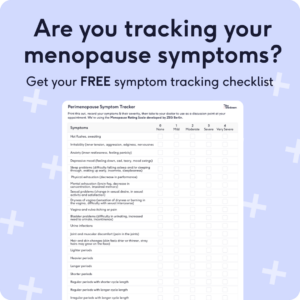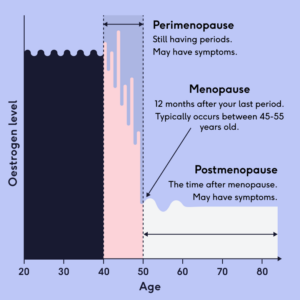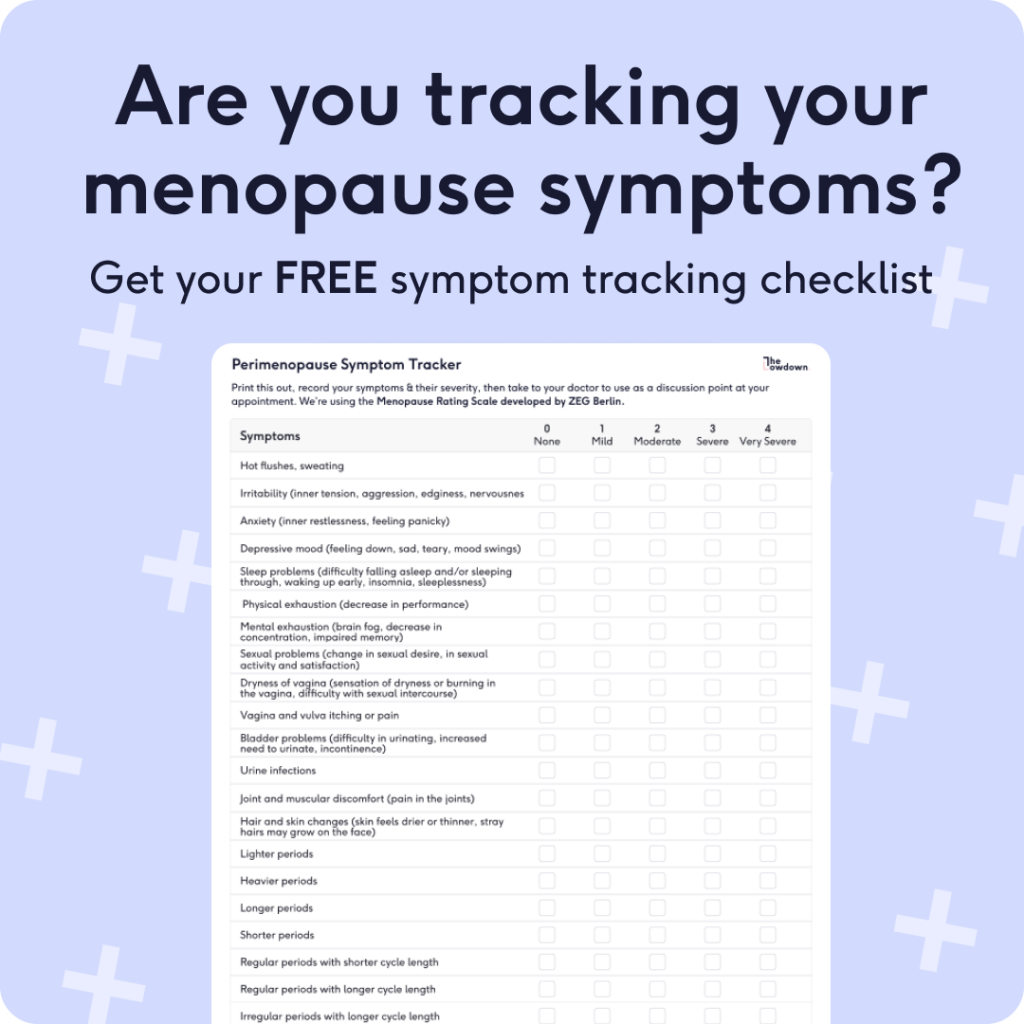
Perimenopause symptom tracker, designed by doctor
What's the lowdown?
There are at least 34 symptoms of menopause.
Our symptom checker gives you an overview of menopause symptoms, based on a scientifically validated score called the Menopause Rating Score MRS.
Symptoms can start during perimenopause, when you’re still having periods but your hormone levels are starting to fluctuate.
Some symptoms are more commonly talked about and recognised than others.
Often women will have more severe symptoms during perimenopause than after they’ve transitioned through the menopause (which is exactly 1 year since your last period). This is because your hormone levels swing up and down so wildly during the perimenopause, and become more stable (but low) after the menopause.more research is happening on perimenopause, more potential symptoms are being identified affecting our entire body. This is because there are oestrogen receptors in every cell of our body, and so changing oestrogen levels can have a huge impact on how we feel.

Why do we get symptoms at perimenopause and menopause?
As we get older, the way our ovaries work changes. When you are older, your ovaries may not release an egg in every monthly cycle. This changes how our hormones behave, and means that oestrogen and progesterone levels can start to vary and fluctuate wildly. These unpredictable swings in our hormones can cause symptoms. The graph below shows how our oestrogen levels change as we start perimenopause, and then after menopause when we’ve had 1 year without periods.
Oestrogen is a very important hormone for women. There are receptors for the oestrogen hormone in almost every cell in the body. This means that when oestrogen levels start to change and vary a lot, symptoms can pop up. These symptoms are really varied. One of the most common symptoms, as you might expect, is changes to your periods. This can be both bleeding patterns, and heaviness of bleeding.

The most well known, well discussed, symptoms of menopause are probably hot flushes and night sweats
Many women will have heard of hot flushes and night sweats during menopause and perimenopause. This is for good reason. Hot flushes and night sweats are quite specific to the menopause transition. Therefore they are easy symptoms for doctors to recognise perimenopause and menopause. A lot of the other symptoms of menopause are less specific, and can also be linked to other health conditions.
This does not mean that you need to have hot flushes or night sweats to be perimenopausal or menopausal. It just might be easier to identify menopause if you are.
No one actually agrees how many symptoms of menopause there are. Some places say 34, some places say 40, whilst others it’s even more than that. The most commonly referred to symptoms tend to be:
- Hot flushes
- Night sweats
- Period changes
- Mood changes (including anxiety, low mood)
- Changes to sleep.
In general, people will split symptoms up into 4 types of symptom:
- Vasomotor symptoms. These are a specific type of symptom which are caused when your blood vessels contract or expand, in response to temperature changes. Vasomotor symptoms include hot flushes, night sweats, and heart palpitations.
- Physical symptoms. These are symptoms which impact your body. Examples of physical symptoms include joint pain, headaches and thinning hair.
- Psychological symptoms. These are symptoms which impact your emotional wellbeing and how you feel. This might include brain fog, memory changes, mood changes and confidence issues.
- Urogenital. These are symptoms which impact your vagina, vulva and the surrounding area, including the bladder and pelvic floor. Examples of these symptoms include vaginal dryness and painful sex.
As you can see… it’s a whole mind and body experience.
But there are many other symptoms of menopause…
Some symptoms are barely mentioned compared to hot flushes and mood changes. This can make it scary if you start to experience symptoms you’ve never heard of – you might not even think of menopause with some of these. Some common, but less well known, symptoms of menopause are:
- Memory changes. It can be scary if you start to forget things, but don’t worry many women will experience this during peri/menopause. It’s usually temporary.
- Your heart beating quickly and strongly. This can feel like a heart attack. But actually this can be a vasomotor symptom that’s associated with menopause.
- Changes to taste and smell. Many women will experience this whilst pregnant, when hormones are changing too. Changes to taste and smell can also happen during perimenopause.
- Not wanting to have sex. This can be a really impactful symptom for women, which impacts relationships and confidence levels. It’s sometimes called having ‘low libido’. This is a very common symptom.
If you’d like to know more about some of the early symptoms of menopause, you can do that here. If you’re struggling with a wide range of symptoms it’s always best to talk to a healthcare professional. We’ve got a handy guide of how to prepare for your first perimenopause appointment with a doctor, and our symptom tracker below can support you with this..
The full list of 34 symptoms… or wait is it 40?
As we say, no one really agrees on exactly how many menopause symptoms there are. More research is being done all the time, which is great, but leads to an ever changing picture of menopause symptoms. We’ve done our best to summarise the 34 most commonly cited symptoms of menopause here:
- Hot flushes
- Night sweats
- Anxiety
- Brain fog
- Period changes
- Heart palpitations or your heart beating suddenly and quickly
- Mood swings
- Depression or low mood
- Anxiety
- Tearfulness
- Brain fog or memory changes
- Irritability or being short tempered
- Panic attacks
- Weight gain
- Lack of confidence
- Low motivation
- Changes to your digestion
- Vaginal dryness
- Itchy skin
- Low libido
- Painful sex
- Burning or tingling sensations on the skin
- Joint pain
- Thinning hair
- Difficulty concentrating
- Feeling tired all the time
- Sleep issues
- Dry eyes
- Bladder issues or urinary incontinence
- Recurrent UTIs
- Thinning nails
- Body odour changes
- Changes to taste and smell
- Feeling tired all the time
How to keep track of what’s going on with you
When there’s a lot going on in life (managing work, kids, ageing parents etc) it can be hard to keep track of how you’re feeling, and symptoms you may be experiencing. Tracking your symptoms over time can be a helpful way to understand what’s going on with you – mentally and physically.
There are lots of different ways you can track including using an app or with notes on your phone or even just old fashioned pen and paper. Our community at the Lowdown like a low-tech way – printing out a simple symptom tracker, sticking it on the fridge, and completing it when you remember. It doesn’t need to be every day. But weekly, keeping track of how things are changing can be useful to allow you to see if things are getting worse over time. Download here.
Tracking can be useful before speaking to your GP about menopause
Speaking to a GP about perimenopause for the first time can be nerve wracking. Having a written record of your symptoms, over a number of days or weeks, can help communicate exactly what is going on. It’s always helpful to be able to give your GP:
- A summary of most severe or frequent symptoms
- How these are changing over time (are they getting worse)
- How long you think they’ve been going on for.
Having these written in a symptom tracking document before the appointment means that you can get straight to the point with the doctor, and use the rest of the 10 minute appointment to talk about different treatment options. Your GP is likely to ask you a few questions, just to clarify what you’re going through. Then they can then talk you through options for treatment. If you’d like to know more about what to expect from your first GP appointment – you can do that here.

Our medical review process
This article has been medically reviewed for factual and up to date information by a Lowdown doctor.






